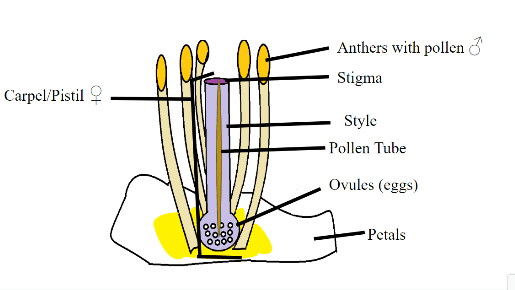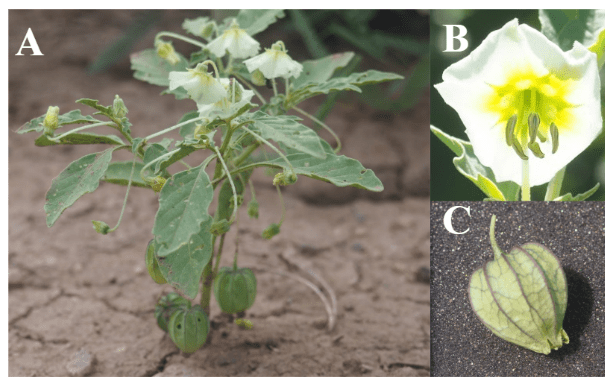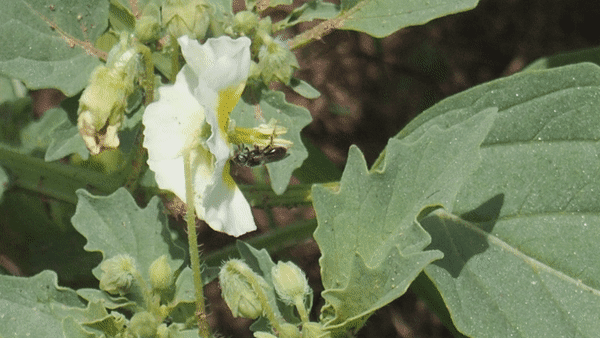The Breakdown of Self-Incompatibility: What happens after pollination?
The following is a guest post from Chelsea Pretz, a PhD Candidate at the University of Colorado, Boulder. Chelsea is interested in general taxonomy and nomenclature of the Physalis, along with the breakdown of self-incompatibility and its effect on evolution. Connect with her on twitter at @impretzively to talk about Physalis!
All of us know something about pollinators. We know that these living creatures move pollen from one flower to another, but have you ever thought of what happens once the pollen has been moved? The pollen will land on the stigma, which is on the top of the carpel, or female organ of the plant. Once the pollen has landed there, it begins its journey down to meet the eggs. The pollen grows a long string that will work its way into the ovary at the base of the carpel, then into the ovules containing the eggs. The sperm from the pollen will fertilize the egg and this fertilized ovule will become a seed. (Fig. 1 shows the flower parts discussed here.)

Fig 1 General plant parts
The pollen’s journey from the stigma down to the ovules is generally a treacherous one. When the pollen starts to grow, it enters a toxic environment, and if it has the correct antidote (genetic make-up) it can grow down the style allowing fertilization to occur. If it doesn’t carry the antidote, the pollen will never reach the ovule to produce seeds. This is what happens in self-incompatible (SI) plants when they are pollinated with their own pollen. If you want a more detailed description of this process check out this previous blog about self-incompatibility.
While there are many benefits for being self-incompatible, there are also many benefits for being self-compatible (SC). If a plant is SC, it can reproduce seeds and fruit without other individuals. Most domesticated plants are SC. In the case of the tomato (Solanum spp.), pollination is still required to move the pollen, but the plant is self-compatible (Sicard & Lenhard, 2011). In some cases, plants are both self-pollinating and self-compatible. This means that this plant does not rely on another individual or even a pollinator to reproduce. These traits are selected by humans but are also selected for in nature. In harsh environments, where the weather is unpredictable, such as the desert, a plant might find itself growing all alone, in which case it will only make seed if it is SC.

Fig. 2 A: Whole plant of P. acutifolia; B: Flower; and C: inflated calyx with fruit inside.
Within one wild species of Physalis (P. acutifolia, Fig. 2), we have recently found such variation, where some plants are SC despite most being SI. P. acutifolia’s range is in the southwestern United States into Mexico. Like most Physalis species, P. acutifolia is self-incompatible, but there are cases where SI has broken and plants are SC instead. This plant typically flowers after the monsoons, but there are several places where they persist throughout the year, such as next to an agriculture field or swamp. In these scenarios, pollinators are inconsistent, (Fig. 3 – A pollinator on P. acutifolia). Without the style producing S-RNases (the protein that creates a toxic environment) any pollen can grow down to the ovules. In some cases, there might be a delay in self-pollen tube growth, but in most cases the self-pollen tube will keep growing. Fig. 4 is of a style from a SC P. acutifolia, accepting its own pollen. The dark pollen tubes are shown growing down the style to the ovules.

Fig. 3 P. acutifolia being pollinated by a native bee.

Fig. 4: Carpel with pollen tubes growing to ovule
The pollen’s journey to the successful fertilization can also be complicated by other factors. After a polyploidization (having more than two sets of chromosomes), it is common for the plant to no longer be able to identify its own pollen and becomes self-compatible (Barringer, 2007). In the case of Petunia hybrida (Entani et al., 1999), the S-RNase is secreted, but in comparison at a lower level than the normal state of diploidy (two sets of chromosomes). With a lower concentration of S-RNases, the growth of the pollen tubes is slowed but does not stop. This is hypothesized to be the reason why P. peruviana is self-compatible, but more work would need to be done to confirm this.
Next time you look at a seed, don’t forget to think about all the work the pollen did to make it there!
Literature Cited
Barringer, B.C. 2007. Polyploidy and self‐fertilization in flowering plants. American Journal of Botany, 94:9.
Entani, Tetsuyuki; S. Takayama; M. Iwano; H. Shiba; F.S. Che & A. Isogai. 1999. Relationship between Polyploidy and Pollen Self-incompatibility Phenotype in Petunia hybrida Vilm., Bioscience, Biotechnology, and Biochemistry, 63:11, pp 1882-1888.
Sicard, A. & M. Lenhard. 2011. The selfing syndrome: a model for studying the genetic and evolutionary basis of morphological adaptation in plants, Annals of Botany, 107:9, pp 1433–1443,
